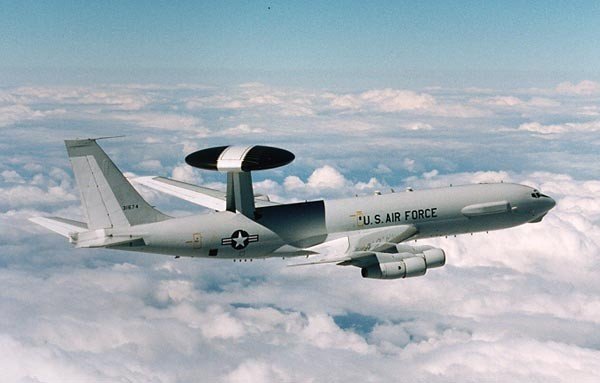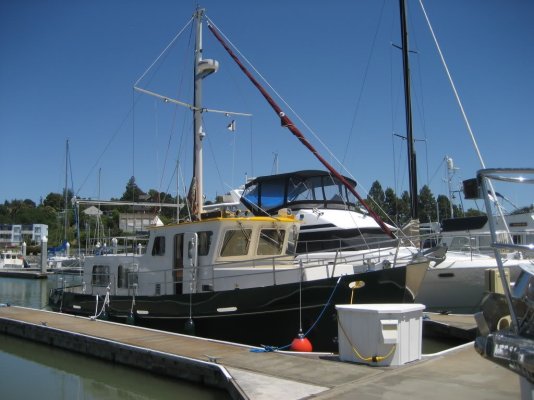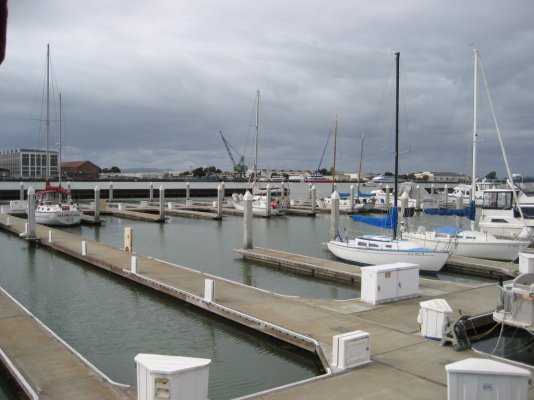Since someone will most likely raise the issue, I'll answer the question before it is asked. Why do some boats have their radar antennas mounted on the face of the flying bridge, which puts anyone sitting on the flying bridge in the path of the transmission beam?
One reason is that on earlier cruisers, like ours, the masts were often of solid wood. And on earlier generation radar units, like the 1980s vintage Raytheon 2600 that was on our boat when we bought it, the cable between the antenna and the display unit was relatively huge. So running this heavy cable down the outside of a wood mast and then the length of the main cabin to the radar display presented some challenges (although it could certainly be done and was done). Mounting the antenna on the face of the flying bridge makes the installation of the radar dirt simple, particularly if, as in our case, the radar display unit is mounted on or in the overhead of the main cabin. The distance from our radar antenna to the display unit is about five feet in an almost-straight line. So almost all of the long connection cable that came with our Furuno is coiled up neatly under the flying bridge console (it was explained to me that you cannot simply cut a radar cable to a convenient length at will--- the length of the cable is "tuned" to the radar unit.)
Also, back in the day, radar equipment tended to be pretty bulky and heavy. And repeater displays, at least for recreational-type radars, were not available. So the equipment tended to be mounted inside the boat, where the reasoning was the helmsman would be steering from anyway in inclement weather.
On our boat we run the radar all the time when we're underway. However, if it's a nice day and one of us or guests want to ride up on the flying bridge we turn the radar off. If we need the radar, we simply tell guests that the cannot go up to the flying bridge. While the transmission signal will not be harmful to anyone sitting on the flying bridge for the length of time they would be sitting there, we nevertheless take the position that no exposure is preferable to even a tiny bit of exposure to a very weak, virtually harmless signal.
At the very bottom of our lengthy to-do list is "Move radar antenna to mast." Whether we ever actually do it remains to be seen--- it would involve a fair amount of work. But the reason we would do this is not for health reasons or to see farther. The upper helm wheel, throttle and shifter mechanisms, steering cable raceway, and other odds and ends of hardware are behind the antenna. While the transmission and return will go through fiberglass (to a degree) they won't through metal. So we have a wedge-shaped blind spot directly behind us. Something big like a Washington State ferry will show up back there, but not smaller power and sail boats.
A lower antenna mounting like ours does offer some advantages in seeing things in the water close to the boat. And up here, with all the overlapping islands, we never run the radar on more than a six mile range because we usually cant see any farther than that anyway. Usually we run on three miles down to an eighth of a mile depending on where we are.* So a higher mast mount would not gain us anything in range that we need or could even use most of the time.
But if one was contemplating the installation of a radar on a boat that didn't have one, I would never recommend a flying bridge face position for the antenna. The advantages of a mast or radar arch position outweigh the couple of advantages of a flying bridge mount.
The only production boat I know of that still uses a flying bridge face mount is the Camano Troll. I have no idea why they do this as it makes no sense to me. The Camano doesn't have a mast and boom arrangement, but a radar arch would be an easy way to go.
-- Edited by Marin on Wednesday 11th of January 2012 12:52:06 PM




